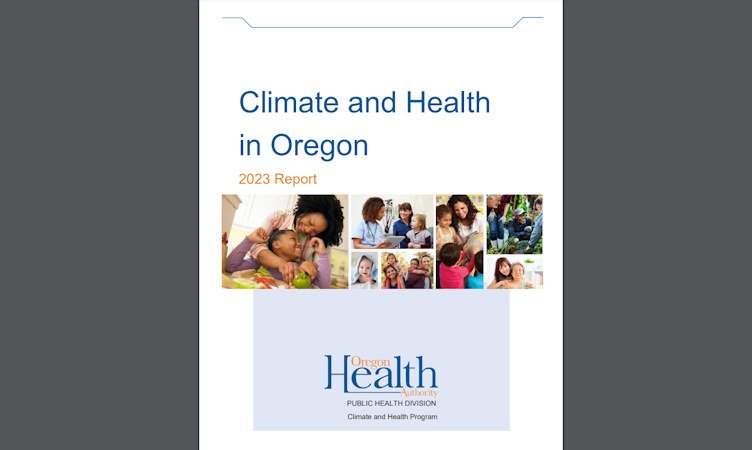OHA’s Climate and Health report highlights opportunities to build resilience against wildfires, drought, extreme heat

PORTLAND, Ore. (KTVZ) — Communities that have been systemically marginalized continue to bear the brunt of extreme climate effects such as wildfires, drought and heat waves, according to a new Oregon Health Authority report. But the agency says opportunities abound for building resilience against future disasters.
Publication of the OHA Public Health Division’s annual Climate and Health in Oregon report for 2023 is a stark reminder that as extreme climate effects continue, according to Friday's announcement, which continues in full below:
Oregon must continue to prioritize climate resilience and green infrastructure in communities at greater risk of the health impacts of climate change.
The report says Oregon communities hit hardest by the 2020 wildfires and 2021 heat dome are still recovering. But the report also says local, Tribal and state agencies and community-based organizations are learning from the disasters and have “made investments in strategies to prepare for the uncertain future.”
“The Climate and Health in Oregon report reflects the fact that extreme climate effects are our past, present and future, and we need to accept this reality by better understanding these events and helping communities mitigate the health risks associated with them,” said Cara Biddlecom, OHA’s interim Public Health Division director. “We must support an equitable approach to climate resilience, with community expertise as our guide.”
The Climate and Health in Oregon report shows numerous examples of direct links between heat and wildfire events and heat-related and respiratory illnesses – using emergency department (ED), urgent care, hospitalization and death data, and temperature and air quality data:
- The number of nights that are warmer than 65 degrees is increasing across Oregon. Warmer nights mean homes without air conditioning do not cool overnight, and people can’t get relief from high daytime temperatures, especially during consecutive days of high heat.
- OHA is seeing health effects on days when the Heat Index – a measure of how hot it feels when relative humidity is factored in with the actual air temperature – is at or above 80 degrees. In 2023, people sought emergency or urgent care at higher-than-expected levels during high Heat Index days.
- Although 2021 saw 109 heat-related deaths and 2022 had 22, the eight health-related deaths in 2023 were still more than the annual count of heat-related deaths in the decade before 2021, when the number of heat deaths did not exceed four per year. During 2021-2023, cardiovascular disease was a contributing cause of 25% of heat-related deaths, and people 50 and older accounted for 87% of heat deaths.
- Levels of particulate matter, or PM2.5, from wildfire smoke are expected to double or triple by the end of the century. The increases in smoke are predicted to cause excess asthma-related ED visits and hospitalizations at a rate of 42 excess asthma events per 10,000 population in 2050. Smoke-related ED visits and hospitalizations for asthma are expected to add nearly $100 million to health care costs in Oregon by that decade.
- American Indian/Alaska Native, Black/African American and Native Hawaiian/Other Pacific Islander people in Oregon have rates of health care visits for air quality-related respiratory illness that are double or near-double the statewide rate of 22 per 1,000 residents.
- Twelve counties – Crook, Deschutes, Douglas, Jackson, Jefferson, Josephine, Klamath, Lake, Lane, Linn, Marion and Umatilla – exceed the state average for both air quality days at or above moderate Air Quality Index, or AQI, and heat index above 80 degrees.
- Nearly 40% of Oregonians (1.7 million) live in the 12 counties that experienced 14 or more days with heat at or above 80 degrees and compromised air quality occurring on the same day during May to September 2023. All these counties are home to Oregonians who report a higher chronic disease burden than the state average.
- In September 2023, more than half of Oregon’s land area experienced severe drought (52%), while 30% experienced extreme drought.
But the report also points to signs of hope in the form of investments that local, Tribal and state government agencies and nonprofit organizations have made in recent years to help Oregon communities prepare for, better respond to, recover from, and build resilience against future disasters:
- Oregon public health modernization investments prioritized by Governor’s budgets and legislative appropriations are helping OHA, all local public health authorities, 57 community-based organizations and the nine Federally Recognized Tribes of Oregon identify climate hazards and at-risk populations, and develop and implement protective strategies.
- OHA’s Public Health Division in 2023 established indicators to measure the public health system’s progress in building community resilience to health effects of climate change, including reducing incidence of heat-related and respiratory illnesses.
- Also in 2023, state and federal leaders increased investments to protect people in Oregon at highest risk of health effects from climate change-driven risks, to make homes more resilient to extreme weather, and to increase tree canopies statewide to reduce heat island effects.
- The Oregon Legislature enacted Senate Bill 1536 in 2022, directing OHA to establish an air conditioner and air filter deployment program, which has since provided thousands of devices to low-income households.
The report also spotlights innovative local projects to bolster climate recovery and response, such as Jackson County’s Community Long-Term Recovery Group, which convenes multi-jurisdictional partners to plan post-disaster recovery and resilience operations; an Oregon Resilience Summit to help local agencies and nonprofits share knowledge, gather ideas and showcase local expertise in effective disaster response, recovery and prevention; and Portland Metro Region Heat Mapping Campaign to understand and reduce health impacts of extreme heat by tracking heat distribution patterns. More local projects are highlighted on these pages.
“By building resilience to climate change in Oregon communities, we are making significant strides toward our goal of eliminating health inequities in the state by 2030,” Biddlecom said.
For more information, visit www.healthoregon.org/climate.